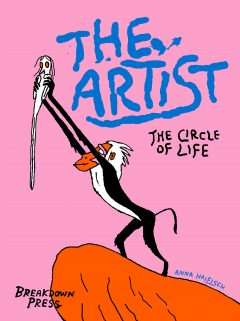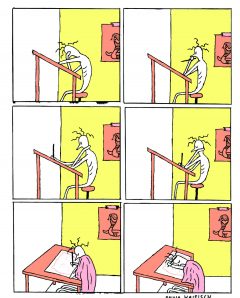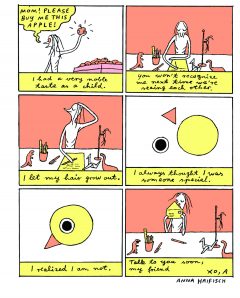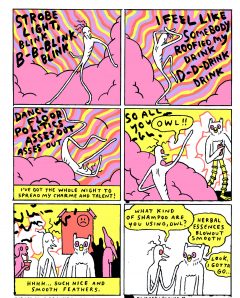“I always think: how can I make The Artist’s life more horrible?” Anna Haifisch on her new book The Artist: Circle of Life from Breakdown Press
Anna Haifisch’s comic strip The Artist, has become a small press favourite thanks to its series of evocative stories about a life suffering for your art. She is back with a new collection of strips starring her bird like muse and we asked her what we can look forward to in The Artist: Circle of Life:
 You’re releasing a new collection of your strips about The Artist – has the character changed or evolved since the previous volume? (It feels like he might be a bit more successful than he was in volume 1?)
You’re releasing a new collection of your strips about The Artist – has the character changed or evolved since the previous volume? (It feels like he might be a bit more successful than he was in volume 1?)
Anna Halfisch: Not yet! He is going to be very successful in the 3rd volume. I am working on it right now. But for the 2nd book he didn’t change much. It’s only his hair which he grew out. He is the same miserable artist as he is in the first book. There are just more awful things happening to him.
The strips feel quite personal in places, are they based on your own experiecenes of being a struggling artist? Or of people you know?
AF: None of the episodes are autobiographic. Some of the stories are taken from my own or my friends’ experiences. But I am exaggerating a lot while I am writing and drawing the episodes. I always think: how can I make The Artist’s life more horrible? Often I feel like sadist, because I love him a lot.
What inspired you to start telling stories about a struggling artist?
AF: I often find drama amusing. And being an artist is quite dramatic. It is the perfect breeding ground for stories that are funny and sad at the same time. Also I love to play around with old fashioned artist myths.
 Why did you choose to represent the artist as a bird? Is there some deep meaning? Or do you just like drawing the bird like character?
Why did you choose to represent the artist as a bird? Is there some deep meaning? Or do you just like drawing the bird like character?
AF: I wanted the character to be fragile and frail. Birds are both. His father is a crane and his mother is a swan. Both are birds with long limbs. That makes The Artist extremely flexible and bendable. It’s fun to draw him.
Do you find your comics appeal to fellow artists who recognise their own struggles in the stories?
AF: When the series was weekly on Vice.com I got a lot of responses from readers who found themselves in his place or who wanted to give him a meal. I think lots of them weren’t artists themselves. The feeling of being a failure seems to be universal.
Although the story can be quite sad and tragic at times, you also seem to give the character a sense of optimism and fun at the same time. Is it important to add some humour to the book?
AF: Oh, of course! I don’t want to depress anybody. Also being an artist can be very great despite economic threats. I really don’t want to keep anybody away from choosing this path. I think that every good or even sad story needs a bit of humour in it. Thats my duty as the creator. I can’t just unload my depressing trash on possible readers and hope they can connect with what I am trying to say. I need to prepare my message a bit.
 The Artist seems to be in both the fine art world and also the small press comics world. Is small press a rich source of humour and stories?
The Artist seems to be in both the fine art world and also the small press comics world. Is small press a rich source of humour and stories?
AF: Oh yes! Both of these worlds. You are meeting the craziest people. And it feels almost normal that everybody has more or less a screw loose. Most of the time it is funny. But of course it can be annoying. especially when you have to deal with tyrants or egomaniacs. These people can be dangerous. I think when you are tabling at a comic fair for one weekend you meet a good cut of characters approaching your table. And then you don’t need to see another human for a while. After this it is great to hide in the studio for a bit until I find people fine again.
You feature things like social media in the story, do you think things like this have made the life of a struggling artist easier or harder?
AF: Totally!! One old artist myth says that it is absolutely acceptable to disappear in the studio for a while until you emerge with a new masterpiece. This is impossible nowadays. Imagine a mediocre successful artist not posting anything in 2 months. People might think you quit or something bad happened. The responsibilities have changed dramatically. Publishers and Gallerists used to be the only ones who would do the public relations for artists. Now it’s up to the artists themselves. It’s a big burden, but also a big chance to spread their charm and talent.
Can you tell us a bit about your process? Do you plan your work out, or is it more instinctive?
AF: It changes a bit from time to time but mostly I start with the writing. This takes the longest. Then I make rough sketches to match possible drawings with the text. The most relaxing part is inking and colouring. Kind of the old school way of drawing comics.
 We love the opening pages you have to each strip. Do you design them to connect to the story? Or do you just choose images or compositions that inspire you/you like to draw? (Like the Lion King parody or the Van Gogh image?)
We love the opening pages you have to each strip. Do you design them to connect to the story? Or do you just choose images or compositions that inspire you/you like to draw? (Like the Lion King parody or the Van Gogh image?)
AF: They are always designed for this specific story. I want them to function as a recap and preview at the same time. I enjoy drawing them because I can put a lot more detail in it. They might be my favourite thing to draw in the whole series.
Do you work on any other series as well as the Artist? And will there be more Artist stories to follow up this volume?
AF: I am working on the 3rd The Artist book. It’s going to be a bird opera – the story of the rise and fall of The Artist told in songs. I feel very stupid when I have to lay it out like this, but I guess this is what I want to do. I just finished a collection of 5 animal stories for my German publisher Rotopol. This might be out in English, too. But I don’t know when. Lately I started a series of water colour drawings I have no clue of what to do with them. But I enjoy drawing them. It feels like a little vacation from comics.
The Artist: Circle of Life is available for £16.99 from Breakdown Press. and you find out more about Anna’s work at hai-life.com



August 14, 2025 @ 6:42 pm
Can you be more specific about the content of your article? After reading it, I still have some doubts. Hope you can help me.
August 19, 2025 @ 12:39 am
Thank you for your sharing. I am worried that I lack creative ideas. It is your article that makes me full of hope. Thank you. But, I have a question, can you help me?
September 7, 2025 @ 6:55 pm
Your article helped me a lot, is there any more related content? Thanks!
October 9, 2025 @ 6:10 am
You’ve got a new fan here! Stream wontumi sports live today afternoon — regional updates and highlights. works great on mobile and desktop. replays, studio discussions, news bulletins. Including today’s schedule. works great on mobile and desktop.
December 21, 2025 @ 7:28 am
Auf Basis des gleichnamigen ersten James-Bond-Romans wird die bekannte Figur als ehemaliger SBS-Soldat neu eingeführt, der auf den Terroristen-Financier Le Chiffre angesetzt wird.
Casino Royale ist ein britisch-US-amerikanischer Agententhriller
nach Ian Fleming und der 21.
‚M‘ weist Bond die verführerische VESPER LYND als Partnerin zu, damit sie ein wachsames Auge
auf ihn hat. Bond findet heraus, dass Dimitrios mit LE CHIFFRE, dem
Bankier einer weltweit operierenden Terrororganisation, unter einer Decke steckt.
Doch nicht alles verläuft nach Plan und Bond beschließt,
auf eigene Faust und ohne den MI6 zu ermitteln, um auch
den Rest der Terrorzelle ausfindig zu machen.
References:
https://online-spielhallen.de/nomini-casino-bonus-code-ihr-weg-zu-spannenden-angeboten/
December 26, 2025 @ 8:41 pm
To get the spins, visit the casino and enter the bonus code “HOTLUCKY1X” by ticking
the promo code box as you create an account. Megapari offers new signups a no deposit bonus of 40 free
spins, worth A$10. Pokiez Casino is offering
20 no deposit free spins for new Aussie players who sign up through our site.
Once done, head over to the “my bonuses” section, scroll to the bottom, and enter the bonus code
“AUPARTY” in the promo code field. If you already have an account with one
of those casinos, you must use that same account for Mega Medusa.
Once your account is set up, close down the cashier,
click on your profile picture/name in the menu and select the “bonuses” section. Dragonslots Casino welcomes all
new Australian players with a free signup bonus of 10
free spins, credited on the Book of Nile pokie with a value of A$1.
There’s no wagering requirement on the bonus, so winnings can be
withdrawn without a playthrough, up to A$50.
You must register a new profile and pass the required KYC checks to claim this
bonus, but you won’t be required to make an initial deposit – this is a “true” no deposit bonus
type. Regular players at LeonBet Casino can use the Referral Bonus to claim up to
150 free spins for Wild West Trueways for each referred user.
Once per week, each Thursday, regular SpinFever Casino account holders
can claim 20 free spins for the Money Train 3 pokie
by depositing a total of A$100 between Saturday and Wednesday.
Each Monday, registered users of LuckyWins Casino can claim 10 free spins for
the Wolf Treasure pokie by applying the bonus code “MONGIFT”.
References:
https://blackcoin.co/tattersalls-hotel-casino/
December 27, 2025 @ 4:52 am
You’ll get automated versions of all the classics — fast-paced
and RNG-certified. Table game fans haven’t been forgotten either.
It’s like stepping into a casino floor without leaving your couch.
Whether you’re into jackpot chases or fast-paced reels, there’s
plenty to sink your teeth into.
Look for platforms that support AUD, Neosurf, crypto, and e-wallets like Skrill or Neteller.
Proper Licensing & RegulationA trustworthy casino always operates
under a valid gaming license, issued by a recognised
authority such as the Curacao Gaming Authority or Malta Gaming Authority.
But with hundreds of websites claiming to offer the “best casino experience”, how do you separate the good from the
bad? The world of online gambling is bigger than ever, especially in Australia.
Click the link below to CLAIM BONUS at SkyCrown Casino and
grab your first deposit bonus today.
Users are responsible for ensuring they comply with all applicable laws before participating in any gambling activities.
Legal Compliance and Responsible GamblingOnline gambling in Australia is regulated by state and federal authorities, with
strict licensing requirements. We do not operate as a betting service provider
or offer any gambling services directly.
References:
https://blackcoin.co/monte-casino-overview/
December 29, 2025 @ 6:09 am
online american casinos that accept paypal
References:
https://morningstar24.com/bbs/board.php?bo_table=free&wr_id=523328
December 29, 2025 @ 6:32 am
online slot machines paypal
References:
https://rhea-recrutement.com/employer/use-paypal-to-play-poker-at-888poker/